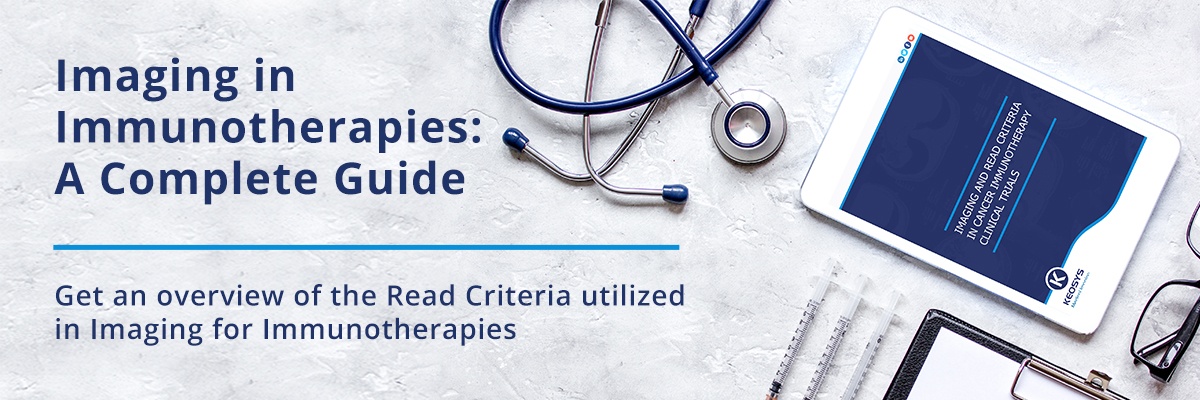This is an excerpt from our free eBook “Imaging and Read Criteria in Cancer Immunotherapy Clinical Trials. To access the full eBook, click here.
Immunotherapy is an expanding field with almost 1000 immunotherapies currently in clinical development. It has become one of the main approaches in cancer treatment alongside surgery, radiation, and chemotherapy.
However, with immunotherapies, clinicians observe different effects than those previously seen with traditional therapies: tumor response can be delayed or patients may show 'pseudoprogression,' which is an inflammation around the tumor caused by the stimulation of the immune system that can be falsely interpreted in imaging as progression.
This means that the standardised Response Evaluation Criteria In Solid Tumors (RECIST 1.1) used to assess tumor response in clinical trials can sometimes underestimate the benefits of immunotherapies.
Additionally, in immunotherapy trials radiologists may see on imaging a wide variety of radiologic manifestations due to immune-related adverse events—colitis, hepatitis, hypophysitis, thyroid enlargement, pneumonitis, or sarcoid-like reactions (lymphadenopathy and pulmonary granulomatosis).
To better capture the response patterns observed with immunotherapies, new read criteria have been developed.
Immune-based criteria are built on 2 key principles:
- Because there can be simultaneous response in baseline lesions and presence of new lesions, new lesions do not necessarily indicate progressive disease
- Progression must be confirmed in 4–8-week follow-up imaging
The first novel criteria for the evaluation of antitumor responses with immunotherapeutic agents was defined in 2009: Immune Related Response Criteria irRC. Based on WHO criteria (which includes the collection of bidimensional measurements of target lesions), irRC criteria incorporates new lesions into the “total tumor burden” instead of immediately calling for Progressive Disease (PD). Additionally, confirmation of PD is required with a second scan if there is an absence of rapid clinical deterioration.
In 2013, Immune-related Response Evaluation Criteria In Solid Tumors (irRECIST) was introduced based on RECIST 1.1. It uses unidimensional measurements and reduces ambiguity found with irRC criteria.
In 2017, a consensus guideline — iRECIST — was developed by the RECIST working group modifying RECIST 1.1 for use in cancer immunotherapy trials. The goal was to ensure consistent design and data collection that would facilitate the ongoing collection of clinical trial data and ultimate validation.
Common Immune-based Criteria
| Criteria | irRC | irRECIST | iRECIST |
| Publication | Wolchok 2009 | Nishino 2013 | Seymour 2017 |
| Model based on | WHO criteria | irRC & RECIST 1.1 | RECIST 1.1 |
| Dimension | Bidimensional | Unidimensional | Unidemensional |
| PD | 25% increase from nadir | 20% increase from nadir | 20% increase from nadir, results in iUPD |
| NL | Does not define PD, measurements of NL are included in SOD | Does not define PD, measurements of NL are included in SOD | Does not define PD, measurements of NL are not not included in SOD |
| Confirmation | 4 weeks | 4 weeks | 4 weeks, no longer than 8 weeks |
PD, progressive disease; NL, New Lesion; iUPD, unconfirmed progressive disease; SOD, Sum of Diameters
Additional read criteria are being explored and developed to take into account the specificities of the cancer or the modality of drug administration:
Other Immune-based Criteria
| LyRIC |
Lymphoma Response to Immunomodulatory Therapy Criteria |
| iRANO |
Immunotherapy Response Assessment for Neuro-oncology Adaptation of the RANO criteria for the evaluation of high-grade gliomas after immune-based treatment |
| itRECIST |
Response Criteria for Intratumoral Immunotherapy in Sold Tumors Adaptation of the RECIST 1.1 criteria to allow for separate response assessment for injected and non-injected lesions in intratumoral immunotherapy trials |



